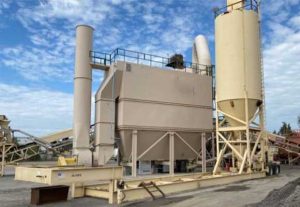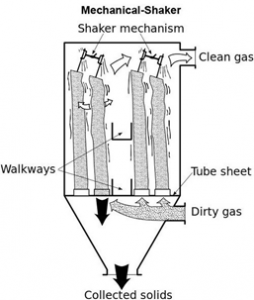What Is a Baghouse in Asphalt Plant?
A baghouse, that is also known under multiple variations of its name, such as a baghouse filter, bag filter, or fabric filter, is a device that controls the level of air pollution control and also has the function to collect dust and to remove particulates or gas that might be released from commercial processes out of the air.
Baghouses are often used by asphalt mixing plants in order to control emission of air pollutants. Once the dust particles have been filtered by the bags, they flow out, while the impurities are left in the bags. The bags inside the filters could be taken down to replace.

What Do Baghouse Filters Remove?
Baghouse systems work by letting the dust-laden gas or air enter them through hoppers, directed into the baghouse compartment.
Depending on the cleaning method, the gas is drawn through the bags, either on the inside or the outside, and a layer of dust accumulates on the filter media surface.
This process repeats until air can no longer move through it. When a sufficient pressure drop occurs, the cleaning process begins. When the compartment is clean, normal filtering resumes.
Advantages and Disadvantages of Baghouse Filter
Advantages
1. Baghouse filters are very efficient.
Dust collection efficiency is so high, it can catch more than 0.3nm dust, dust gas purification to 15mg/m3 or below.
2. They are a more economical option.
A baghouse dust collector usually needs periodic changes in the bag, requiring less maintenance.
3. Filters are easy to change.
This being one of the biggest advantages of these baghouse dust collectors. The baghouse can be accessed through the bottom and side, and there’s enough space for a worker to go inside to change the filters with ease.
4. Filters are more durable.
One of the biggest advantages of these are that they are more durable, because these filters have been designed in a way that they can also work in harsh conditions.
5. Versatile.
Unlike other types of dust collectors, baghouse dust collectors can be used at different places, such as manufacturing industries or food industries. These dust collectors are not only very famous, but also used widely.
Baghouses are a great solution, no matter the size of the dust particles that you need evacuated, especially in case if the size of the dust particles is larger than 50 microns, when these bag dust collectors are an ideal option.
Disadvantages
However, the Baghouse filters are limited by both high temperatures and corrosive chemical.
Even more than that, when using a baghouse filter, with regard to different types of gas, the corresponding type of cloth bag should be selected.
As a plus on the disadvantages, there is a high demand to often change the cloth bag, and the cloth bag consumes a large amount of money.
When collecting dusty gases with high humidity, there should be taken moisturizing measures, in order to prevent “paste bags” from forming due to dew condensation. Therefore, baghouse dust gas has a certain request for the humidity of the gas.
Although their larger resistance, baghouse filters have a common pressure loss of around 1000 ~ 1500Pa.
How Does the Baghouse Work for Asphalt Mixing Plant?
Actually, the dust removal work for asphalt mixing plant mainly includes two parts: dust collecting and dust cleaning. A baghouse collects dust by forcing particle-laden gas through fabric filter bags, where particles are captured by physical filtration mechanisms and a dust cake forms on the bag surface, while cleaned gas exits the system and accumulated dust is periodically removed by a cleaning cycle.
There are three main methods on cleaning bags of dust removal system in asphalt plant.
1. Mechanical Shakers
In mechanical-shaker baghouses, tubular filter bags are fastened onto a cell plate at the bottom of the baghouse and suspended from horizontal beams at the top.
Dirty gas enters the bottom of the baghouse and passes through the filter, and the dust collects on the inside surface of the bags.
The dust on the innet surface of the bags is removed by periodically stopping the gas flow and mechanically vibrating or shaking the suspended filter bags, causing the dust layer on the inside surface of the bags to crack and fall into the hopper by gravity.
2. Reverse air
In reverse-air baghouses, the bags are fastened onto a cell plate at the bottom of the baghouse and suspended from an adjustable hanger frame at the top.
Dirty gas flow normally enters the baghouse and passes through the bag from the inside, and the dust collects on the inside of the bags.
The dust inside the bags is removed by temporarily stopping the dirty gas flow and introducing low-pressure reverse airflow, which gently collapses the filter bags and causes the dust layer to detach and fall into the hopper.
3. Pulse Jet
In pulse-jet baghouses, individual bags are supported by a metal cage (filter cage), which is fastened onto a cell plate at the top of the baghouse.
Dirty gas enters from the bottom of the baghouse and flows from outside to inside the bags. The metal cage prevents collapse of the bag.
In this kind of dust removal system, the dust on the bags is removed by injecting short bursts of compressed air into the filter bags, causing them to rapidly expand and flex, which dislodges the dust cake from the bag surface and allows it to fall into the hopper.
For more technical information, please move on to the page “asphalt plant baghouse“.



